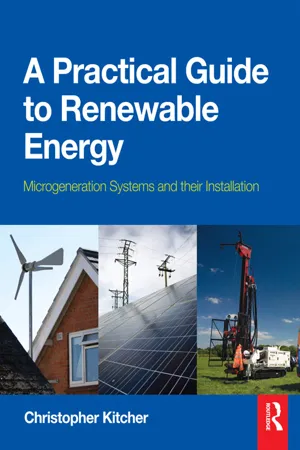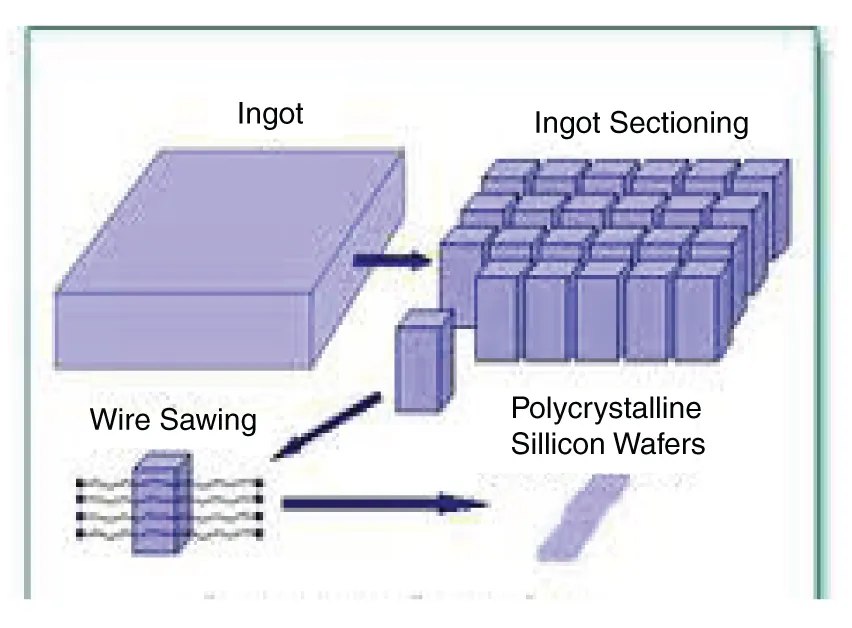
This is a test
- 152 pages
- English
- ePUB (mobile friendly)
- Available on iOS & Android
eBook - ePub
A Practical Guide to Renewable Energy
Book details
Book preview
Table of contents
Citations
About This Book
The renewable energy field is an area of rapid growth with many government initiatives in place to encourage mainstream take-up of energy-saving technologies in buildings.
In the UK, over 100, 000 students per year undertake plumbing and electrical installation vocational courses that will be directly affected by these developments. More importantly, there will be an even greater number of professionals studying toward renewable energy installation and inspection courses that need this information.
This new book from bestselling author Chris Kitcher provides an overview of all of the latest technologies and how they can be incorporated. Students and professionals will use it on a range of courses and as a reference on-site.
Frequently asked questions
At the moment all of our mobile-responsive ePub books are available to download via the app. Most of our PDFs are also available to download and we're working on making the final remaining ones downloadable now. Learn more here.
Both plans give you full access to the library and all of Perlego’s features. The only differences are the price and subscription period: With the annual plan you’ll save around 30% compared to 12 months on the monthly plan.
We are an online textbook subscription service, where you can get access to an entire online library for less than the price of a single book per month. With over 1 million books across 1000+ topics, we’ve got you covered! Learn more here.
Look out for the read-aloud symbol on your next book to see if you can listen to it. The read-aloud tool reads text aloud for you, highlighting the text as it is being read. You can pause it, speed it up and slow it down. Learn more here.
Yes, you can access A Practical Guide to Renewable Energy by Christopher Kitcher in PDF and/or ePUB format, as well as other popular books in Physical Sciences & Energy. We have over one million books available in our catalogue for you to explore.
Information

C H A P T E R
1
Solar photovoltaic
systems
The combination of the Greek word for light, which is photos and the term used for a unit of electromotive force, which is volt is combined to form the word photovoltaic. This is used as the name for a system which converts the energy, provided by the sun (light) directly into electricity by using a solid state device which is called a photovoltaic cell.
The sun supplies us with energy in the form of solar radiation. The intensity of this solar radiation is known as irradiance and is measured in watts per metre square (W/m2). In good weather when the sun is at its peak the irradiance may reach 1000Wm2. Irradiance is also referred to as insolation (not to be confused with insulation) which is irradiance × time and the amount of irradiance which reaches the earth is made up of direct insolation, and diffuse insolation.
Direct insolation is the amount of solar irradiance measured at a given point on earth perpendicular to the sun’s rays, and diffuse insolation is the amount of radiation which reaches the same point but which has been reflected or scattered by elements which make up the earth’s atmosphere. It is thought that around 60% of the solar radiation which reaches the UK is diffuse radiation although this alters depending on the amount of cloud. Clearly on a fine bright day with little or no cloud most of the radiation would be direct, whereas in the winter and on cloudy days the radiation would be almost entirely diffuse. Over a year this averages out at 60% diffuse and 40% direct.
It is the job of the photovoltaic cell to capture and convert into electrical energy the solar radiation which falls on to it.
These cells are generally constructed using silicone although other materials are being developed. Silicon is the most abundant element on earth after oxygen, and of course this makes it available in almost unlimited quantities. For use in the electronics industry silicon has to be very pure and the process of purifying the silicone is very expensive. The silicon used in the solar industry does not have to be as pure


A Practical Guide to Renewable Energy
2
1
as that used to make semiconductors and for this reason much of the silicon used is the waste from the semiconductor industry, this of course helps to reduce the cost. Unfortunately with the increased demand for photovoltaic panels there is not enough waste to fulfil the demand and the shortfall has to be made up of pure material.
As with anything else, due to increased demand new methods of production will be developed which in turn will reduce the cost of the materials.
There are four common types of silicon photovoltaic cells in use and these are:
• Mono-crystalline (single crystal) silicon cells
• Polycrystalline silicone cells
• Ribbon pulled silicon
• Amorphous silicon.
Mono-crystalline cells (c-Si)
Mono-crystalline cells are the most expensive as they are formed of pure silicon, they are also the most efficient with an efficiency of 15 to 18%.
These cells are sliced thinly from round rods of silicon (Fig. 1.1a/b), but if they are fitted into panels in this shape there will be a large area of the panel which will not be producing energy (Fig. 1.2); for this reason they are rarely used. It is possible to form the unit holding the cells out of transparent materials and in some instances where light is required.
In an area below the module the use of round cells would be an option.
It is better for energy production if the cells are cut to form a square but of course this would produce a lot of unusable waste (Fig. 1.3).
Figure 1.1 (a) Silicone after it is cut. (b) Silicone before it is cut.



Solar photovoltaic systems
1
3
Using square cells would certainly allow the modules to produce more energy but the cost of the cells would rise due to the amount of silicon which would need to be discarded.
A better option, and one that is often used with mono-crystalline cells, is to partially trim the round cells (Fig. 1.4a/b), this of course reduces the amount of waste silicon and unused area on the solar module which in turn helps keep the manufacturing costs down while making the best use of the available area.
Figure 1.2 A number of round cells fitted side-by-side onto a panel with a large area of panel not producing energy.
Figure 1.3 Drawing showing how a square cell will produce more energy when fitted into a solar panel.



A Practical Guide to Renewable Energy
4
1
The natural colour of a mono-crystalline cell is grey, however to make the cells more efficient it is common for manufacturers to apply an anti-reflective coating to them. When an anti-reflective coating is applied the colour is uniform and will be from black to very dark blue. Each cell will usually be between 100mm2 and 150mm2 with a thickness of 0.2 to 0.3mm.
Polycrystalline silicon cells (c-Si)
Polycrystalline cells are made by melting the material and casting it into large blocks. When the blocks cool down they form a solid block of silicon crystals. These blocks are then cut into square bars (Fig. 1.5) from which thin slices of silicon are cut, and these are usually around 3mm thick and can be from 100mm2 to 200mm2. Using larger cells brings down the costs as each module will need fewer cells. The efficiency of this type of cell is from 13 to 16...
Table of contents
- Cover
- Title Page
- Copyright Page
- Contents
- Preface
- Acknowledgements
- Chapter 1 Solar photovoltaic systems
- Chapter 2 Solar thermal heating
- Chapter 3 Domestic wind turbines
- Chapter 4 Heat pumps
- Chapter 5 Combined heat and power units (CHPs)
- Index
- Back Cover